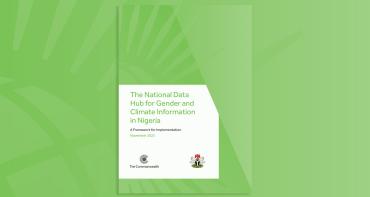Workplace harassment is an epidemic that blights the lives of women and girls around the world in formal and informal ‘workplace’ spheres. It is used to discriminate against or violate the human rights of over half of the world’s population.

This blog is part of the Commonwealth’s ‘16 Days of Actions’ series, designed to showcase multi-disciplinary national solutions in addressing violence against women and girls. These proven solutions build on the collective experience of the 54 member countries – representing one-third of humanity – which can be replicated elsewhere to create a safer world for every woman and girl. Read the full series here.
I lead a peaceful life and love working with the NO MORE Foundation, where I engage with people who are committed to the safety of everyone. I spent many years previously working in Human Resources, where it was my privilege to work with people who were the reason our business was a success. So much of the work we delivered was to support our colleagues. But sometimes that support was for people who were being harassed.
Workplace harassment is an epidemic that blights the lives of women and girls around the world in formal and informal ‘workplace’ spheres. It is used to discriminate against or violate the human rights of over half of the world’s population.
Harassment on the rise
COVID-19 has brought tremendous changes to how we work. Workplace harassment has not ended, with reports indicating that this behaviour is on the rise. This includes cyberbullying, online sexual harassment, inappropriate behaviour online, and heightened exertion of power and control during these challenging times.
There are many types of workplace harassment, including:
- discriminatory, such as bullying or harassment on the grounds of race, gender, sexual orientation, nationality, religion, disability, and age.
- psychological, which is when victims often feel put down and belittled on a personal level, a professional level or both.
- physical, which includes physical, attacks, intimidation, threats or punishment and physical gestures.
- personal, such as offensive jokes, inappropriate comments, humiliation, critical remarks, ostracizing behaviours, and intimidation.
- sexual, which is sexual in nature and generally includes unwanted sexual advances, conduct or behaviour. Most perniciously this includes sexual assault and rape.
Workplace harassment is the power and control of one person over another. The behaviour is exploitative in nature, and does not recognise the boundaries of economic empowerment, religious belief, race, ethnicity, gender identity or levels of education. People who harass may include fellow work colleagues, a member of the public, a superior in the business, a supplier for the business or a contractor.
Knock-on effects
The problem impacts victims’ physical and mental health and also leads to higher employee turnover and increased absenteeism. Recent studies show that the knock-on effects have decreased employers' returns and profits, as well as women’s participation in the labour force.
Despite being a universal experience for women globally and having detrimental impacts on the economy, a 2018 World Bank report found that 59 out of 189 countries had no specific legal provision prohibiting sexual harassment in employment. Workers at highest risk are in the accommodation and food services, retail, manufacturing, transportation, health and social care and farming sectors.
In the Commonwealth, twenty of the 54 member countries do not have legislation on sexual harassment in employment, while 23 do not have criminal penalties or civil remedies for sexual harassment in the workplace.
Many employers have outstanding protocols to support employees who are the victims of harassment. At the Corporate Alliance, a British charity addressing domestic, sexual, and workplace violence, I collaborated with companies that worked diligently to support all employees ensuring best practice included creating a gender-sensitive harassment policy, a system to manage complaints effectively, a procedure to handle sexual assault, mandatory anti-harassment training for all employees and a process to report progress to national frameworks.
- A workplace policy and protocol must be available to all employees, contractors, clients and visitors. A culture of zero tolerance for any type of harassment must be in place.
- A system where all complaints of harassment are taken seriously is fundamental. Employers must handle any investigation fairly and sensitively to the person who made the complaint and the accused. There must be clear signposting of the confidential complaint and independent investigation process without retaliation or break in confidentiality. There must be immediate action when a sexual assault or rape occurs. There must be punitive action for harassment behaviours depending on the outcome.
- Accredited training should be provided to all employees and contractors annually.
- Local and national reporting mechanisms annually will further identify how women and girls have been protected against harassment.
Putting employees first
At NO MORE, we believe strongly in the power of equality and responsibility. We recognise that women are the largest contributors to small and less formal workplaces and know harassment must end.
I have worked with employees and employers who have been traumatised by workplace harassment. It is pernicious and can be deadly, especially for women, which warrants immediate focus and response.
I urge employers across the Commonwealth to create policies to protect their employees, especially women, from workplace harassment, and allocate adequate resources to enforce the statutory rules. This is not just the right but smart thing to do – because we know when women are supported in the economic setting, the whole society benefits.
The ‘16 Days of Actions’ blog series is part of the Commonwealth Says NO MORE campaign. Read the full series here, learn more about the Commonwealth’s work on ending violence against women and girls here – and join in the conversation on social media by using #CommonwealthSaysNOMORE.



